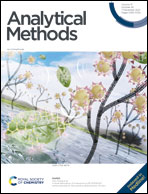A general solvent system for the analysis of lignosulfonates by 31P NMR†
Abstract
31P nuclear magnetic resonance (NMR) spectroscopy is the most common and most accurate analytical method to quantitatively determine the hydroxy group contents of technical lignins. However, for lignosulfonates, liquid-state NMR analysis is often limited due to solubility problems in commonly used solvent systems, which may arise from the broad range of lignosulfonates from different wood sources, pulping conditions, and purification procedures used in biorefineries. Finding a suitable solvent system is even more difficult for chemically modified or fractionated lignosulfonates. In this study, a novel and fast approach for the solubilization of genuine, modified, and fractionated lignosulfonates and subsequent quantitative analysis of hydroxy groups by 31P NMR after derivatization with 2-chloro-4,4,5,5-tetramethyl-1,3,2-dioxaphospholane is presented. The implementation of the ionic liquid 1-ethyl-3-methylimidazolium chloride [emim]Cl to the already validated and commonly used DMF/pyridine solvent system caused complete solubility of previously insoluble samples, especially in the case of hard-to-dissolve ammonoxidized lignosulfonates. The applicability, accuracy, and robustness of the novel solvent system for 31P NMR analysis were comprehensively investigated with lignin model compounds and commercial lignosulfonates, including otherwise insoluble, real-world lignosulfonate specimens. The results were compared to the conventional DMF/pyridine solvent system. With the novel solvent system in hand, a much larger number of different lignosulfonates can be analyzed. In particular, the hydroxy group contents of ammonoxidized lignosulfonates were determined for the first time directly by 31P liquid-state NMR.



 Please wait while we load your content...
Please wait while we load your content...